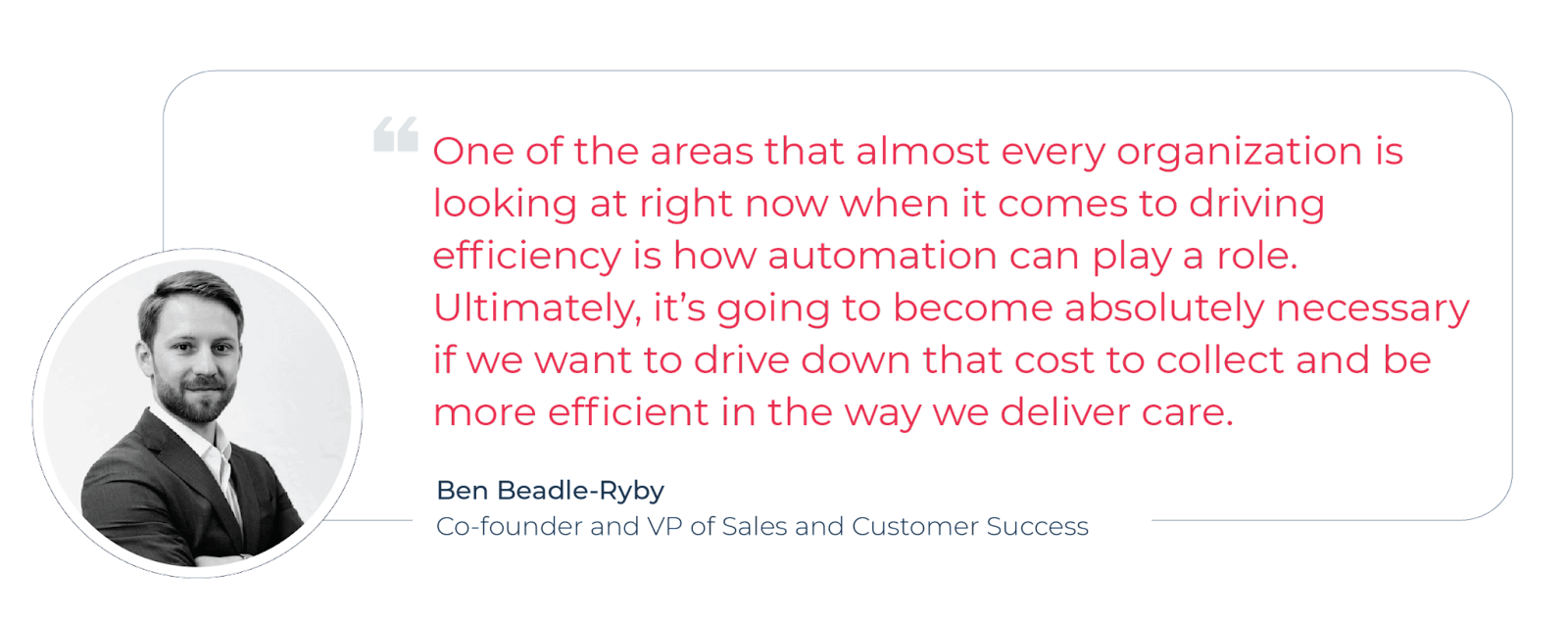The Gist
At the Becker’s Hospital Review’s 9th Annual CEO + CFO Roundtable Conference, revenue cycle leaders talked about new ways to drive efficiency and generate revenue in the new year. From strategy, partnerships, and private equity to innovation, automation, and beyond, they looked at how to solve the challenges of RCM.
Last week, Becker’s Hospital Review held its 9th annual CEO + CFO Roundtable Conference in Chicago. The event brought together more than 150 speakers from hospitals and health systems to talk about the most critical issues affecting organizations, as well as strategy, partnerships, innovation, and everything in between.
In the session, How Revenue Cycle + Finance Leaders Can Prioritize Efficiency and New Revenue Streams in 2022, revenue cycle experts from large and small health systems and private companies addressed adding new service lines, how to improve revenue cycle KPIs, and the role that automation will play.
The panel was moderated by Ayla Ellison, editor-in-chief of Becker’s Hospital Review, and included panelists:
- Ben Beadle-Ryby, co-founder and vice president of sales and customer success at AKASA
- Rick Carrico, executive vice president and CFO at WakeMed Health & Hospitals
- Patricia McClure-Chessier, hospital CEO at Signature Healthcare Services
- Beverly Sinkuler, CFO at Levi Hospital

Here, we have summarized three key takeaways from the panel discussion that healthcare organizations can use to drive efficiency, generate revenue, and solve the biggest RCM challenges in 2022 and beyond.
1. Look to New Services, Private Equity, and Innovation to Increase Revenue
In 2022, healthcare organizations will be looking at ways to pivot, add service lines, and make the most of their facilities to better serve their patients, reduce costs, and increase revenue.
Some ideas discussed were outpatient services and physician group acquisition or partnership strategy to drive volumes and increase referral networks.
Take WakeMed Health & Hospitals in Raleigh, North Carolina. It is looking to expand behavioral health services and evaluate what an inpatient model would look like.
Levi Hospital in Hot Springs, Arkansas, is planning to convert its small acute care floor, which is being used only 20 times a year, into a rehabilitation unit for patients who need to detox from drugs and can then receive therapy.
Signature Healthcare Services is adding several new facilities and services, including offering electroconvulsive therapy (ECT), an intensive outpatient program (IOP), and a partial hospitalization program (PHP) for first responders, plus an inpatient unit for military members and a woman’s wellness program for those who need treatment for trauma.
“What we’re finding is that it is very important to address trauma and the specific trauma that different people are experiencing,” said McClure-Chessier.
Other ideas that were explored on the panel were private equity venture funds and innovation. WakeMed Health & Hospitals, for example, is working with a private equity or venture fund.
“When you reach out to people at the frontline and all aspects of the patient process cycle, the ideas that come up are interesting, and some of these have reached a stage where they could be advanced to commercialization,” Carrico said.
Finally, healthcare organizations are moving away from thinking about the revenue cycle as a cost center.
“Increasingly, organizations are thinking about how the revenue cycle can actually serve our strategic needs and be a partner with our clinical and strategic goals in order to drive new revenue streams moving forward,” shared Beadle-Ryby.
Read more about the future of AI and automation in healthcare.
Increasingly, organizations are thinking about how the revenue cycle can actually serve our strategic needs and be a partner with our clinical and strategic goals in order to drive new revenue streams moving forward.
Ben Beadle-Ryby – Co-founder and VP of Sales and Customer Success at AKASA
Ben Beadle-Ryby, Co-founder and VP of Sales and Customer Success at AKASA
2. Identify Ways to Drive Efficiency
When the panelists were asked how they’re driving efficiencies for their organizations, telehealth, hospital at home, remote patient monitoring (RPM), and home health were all discussed.
When it comes to the revenue cycle specifically, Signature Healthcare Services uses a revenue cycle vendor to audit a small number of patient records and plans to roll out the solution across the organization.
“With this audit, we’re able to see trends from different clinicians and what billing opportunities we missed,” McClure-Chessier said.
Signature Healthcare Services is also evaluating all of its facilities’ utilization review committees, has implemented a robust denial management program with associated goals, and has made a significant push to make sure bills are generated within five days of discharge.
“That is what we consider being efficient, and that also increases the likelihood that the bill is going to be paid,” said McClure-Chessier.
Although most hospitals and healthcare systems are facing labor shortages, Levi Hospital has eliminated unnecessary positions. “There are people that have not really been contributing to the success or even the workflow and drawing a paycheck,” Sinkuler said. Additionally, they will be implementing an EHR system and will be looking to hire individuals who understand how to use it.
Another topic that was discussed was how the lessons of COVID will affect hospitals and health systems moving forward.

“As we start to turn the corner on COVID, organizations are going to start looking at their long-term strategy and particularly focusing on where COVID has acted as an accelerator for changes that may be here for the foreseeable future,” according to Beadle-Ryby.
For example, organizations are looking at how to become more operationally resilient and how to respond to changing patient volumes and labor shortages.
When it comes to the revenue cycle, in particular, driving efficiency has been a long-term challenge. Cost to collect, which is typically around 3% of net patient revenue, has plateaued, mostly because labor has driven that spend.
“One of the areas that almost every organization is looking at right now when it comes to driving efficiency is how automation can play a role,” continued Beadle-Ryby. “Ultimately, it’s going to become absolutely necessary if we want to drive down that cost to collect and be more efficient in the way we deliver care.”
Learn more about the current challenges and best practices for hospital revenue cycle management.
One of the areas that almost every organization is looking at right now when it comes to driving efficiency is how automation can play a role,” continued Beadle-Ryby. “Ultimately, it’s going to become absolutely necessary if we want to drive down that cost to collect and be more efficient in the way we deliver care.
3. Start Planning Now for 2022 — and Beyond
A significant takeaway from the panel was for organizations to have a 3- to 5-year strategy in place to increase operational efficiencies, better serve patients, and drive revenue.
“It’s very important to assess the needs of your community [and] pay attention to your data and trends because there could be some opportunities right in front of you that you could have possibly overlooked,” said Patricia McClure-Chessier.
Reading the trades and staying on top of the trends and best practices in healthcare and other industries is vital to staying relevant in an ever-changing industry. “I like to see what the larger places are doing, the larger cities, because it could very well translate to what we do,” Sinkuler said.
The panelists also talked about using AI and machine learning automation to optimize their revenue cycle operations and appropriately allocate their workforce.
“From our standpoint, we’ve got to figure out how to make automation work better because I’m confident all others of the healthcare spectrum are doing the same thing. Because we don’t have mathematicians and data scientists within WakeMed, we’re going to look to try to find partnerships to do that,” Carrico said.
At the end of the session, the floor was opened to questions, and one of the attendees asked for a further explanation about automation. Beadle-Ryby explained that medical billing and the revenue cycle are ripe for automation, especially because many organizations are relying upon their source systems to serve primarily as workflow tools that assist and augment staff.
Here are four questions to ask before implementing AI in healthcare revenue cycle operations.
“When it comes to process automation, there are a lot of opportunities to take over a lot of the repetitive work that’s being performed by that frontline staff in order to up-skill them and have them doing more important, patient-facing, value-add work for the organization,” Beadle-Ryby said.
To find out more about the enduring advantages an advanced automation solution driven by AI and ML can provide, schedule a demo with AKASA.










